Dell U3011 Review: Dell's New 30-inch Flagship
by Brian Klug on January 13, 2011 9:17 PM ESTViewing Angles
The U3011 has superb viewing angles, just like we've grown accustomed to seeing from IPS panels. Even at the far extreme horizontally, there's none of the purple I'm used to seeing from TN panels as you move off-axis. In the vertical direction, I saw the same thing with almost nothing to complain about. I did notice some glare at the extreme angles, but again that's dependent on where you're sitting and where light sources are located.
I think this is an excellent opportunity to talk about IPS graininess, something we really haven't discussed before. Of the IPS panels I've used to date, all of them have had some high frequency grain on the surface from a combination of coating and interference at the interface. Thankfully the U3011 has a combination antireflection coating and hard coating, and subjectively there seems to be less grain than I've seen on other displays.
Color Quality
Next up are the ever-important color quality metrics. As usual, we report two main quality metrics: color accuracy (Delta-E) and color gamut. Color gamut refers to the range of colors the display is able to represent with respect to some color space. In this case, our reference is the AdobeRGB 1998 color space, which is larger than the sRGB color space. Our percentages are thus reported with respect to AdobeRGB 1998, and larger is generally better unless you're dealing with sRGB content and colorspace-unaware software.
Color accuracy (Delta E) refers to the display’s ability to display the correct color requested by the GPU and OS. The difference between the color represented by the display, and the color requested by the GPU is our Delta-E, and lower is better here. In practice, a Delta E under 1.0 is perfect - the chromatic sensitivity of the human eye is not great enough to distinguish a difference. Moving up, a Delta E of 2.0 or less is generally considered fit for use in a professional imaging environment - it isn’t perfect, but it’s hard to gauge the difference. Finally, Delta E of 4.0 and above is considered visible with the human eye. Of course, the big consideration here is frame of reference; unless you have another monitor or some print samples like a Gretag Macbeth color checker card to compare your display with, you might not notice.
As I mentioned in our earlier reviews, we’ve updated our display test bench. We’ve deprecated the Monaco Optix XR Pro colorimeter in favor of an Xrite i1D2 since there are no longer up-to-date drivers for modern platforms. We're trying to find an i1Pro to use as well.
For these tests, we calibrate the display and try to obtain the best Delta-E we can get at both 200 nits of brightness for normal use, and 100 nits for print brightness. We target D65 and a gamma of 2.2, but sometimes the best performance lies at native temperature and another gamma, so we try to find what absolute absolute best-case performance for each display. We also take an uncalibrated measurement to show performance out of the box using either the manufacturer supplied color profile, or a generic one with no LUT data. For all of these, dynamic contrast is disabled, and displays are left to settle for a half hour after making changes. The U3011 is CCFL-backlit, and I used a settle time of 30 minutes accordingly.
First up is uncalibrated Delta-E performance. For this test, I took the monitor out of the box, connected it over DisplayPort, adjusted to 200 nits, and ran our usual GMB color checker test. Results aren't that great, sadly.
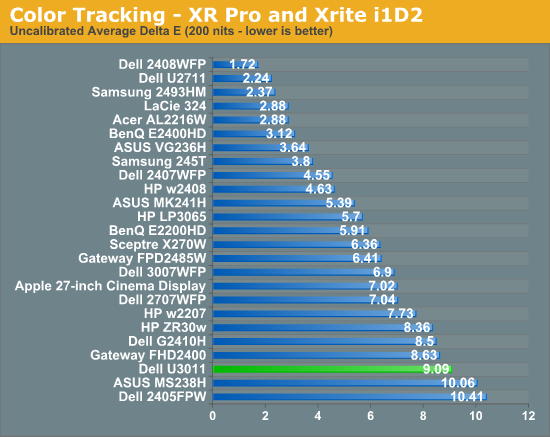
I mentioned earlier that the U3011 we got from Dell for testing came with no factory calibration report. After checking up with them, we learned this is a pre-production unit identical to what's shipping now, minus that factory calibration. That's something we can live with, especially since we recommend every display be calibrated, but still unnerving.
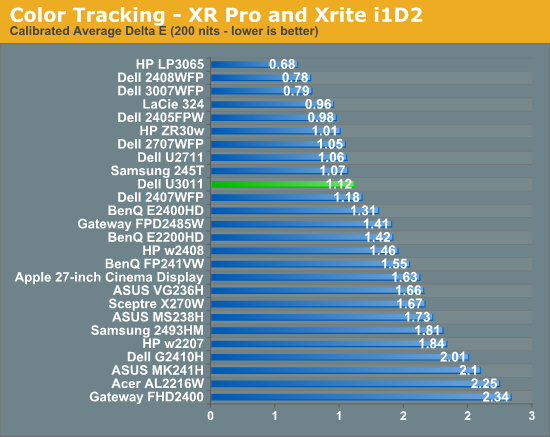
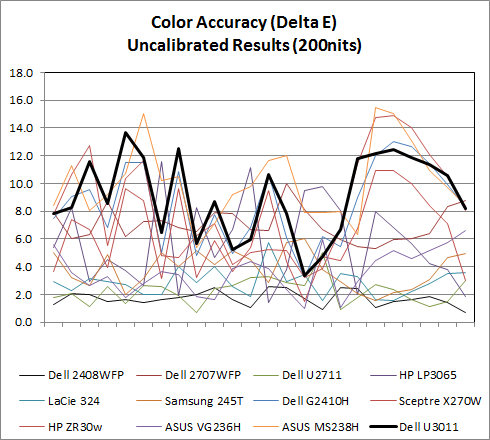
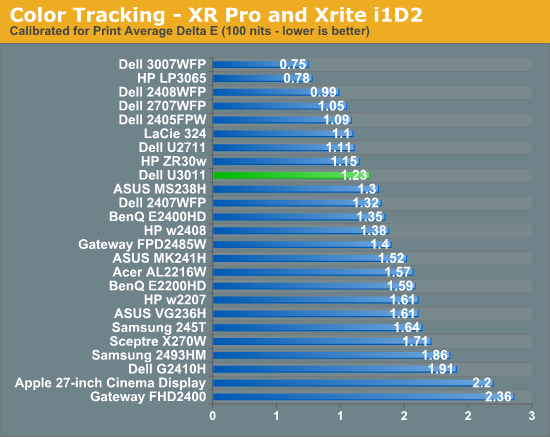
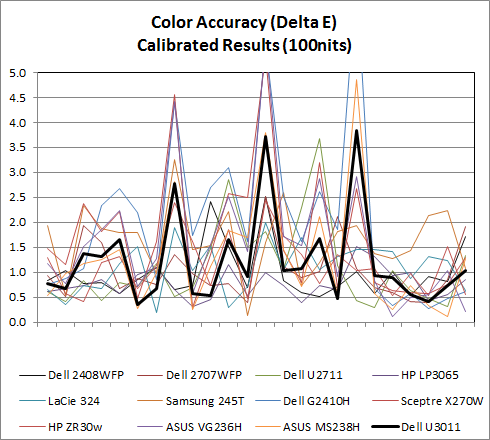
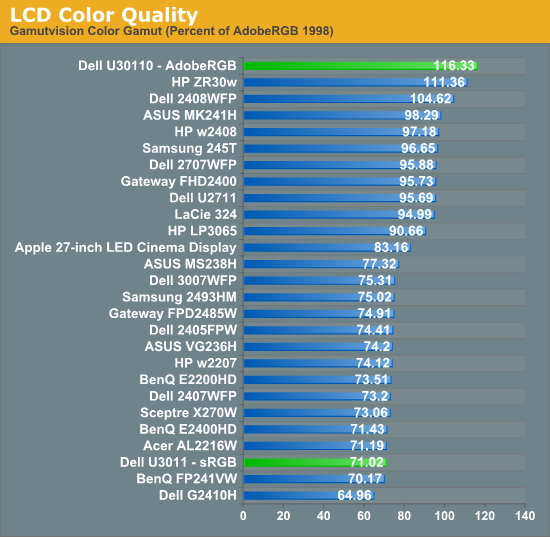

AdobeRGB Mode
sRGB Mode
Calibrated Delta-E is very good, though I'm still surprised the U3011 can't get under 1.0 on our tests. I'm starting to suspect that our i1D2 isn't quite as good as the Monaco Optix XR Pro, and have started looking for an i1Pro spectroradiometer as a result so we can have something more accurate going forward. That said, performance is still more than adequate for professional work. These two calibrations were performed in the sRGB mode at D65.
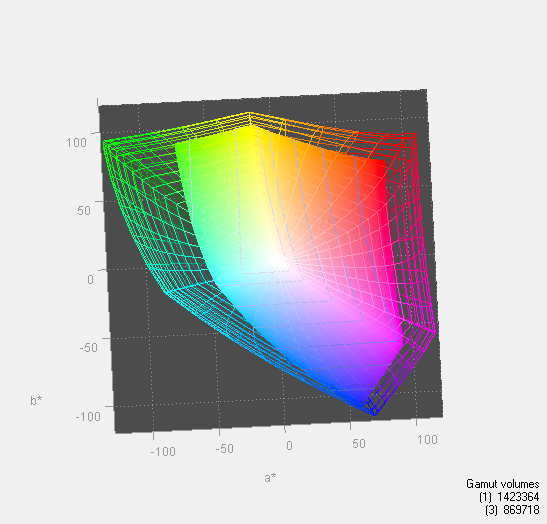
In addition, the U3011 has modes for AdobeRGB color space and sRGB in the OSD, something extremely useful for doing work and not getting oversaturation in applications that lack color management. You can immediately see the effect of those two modes in the color gamut measure above. Letting the monitor free to use its entire gamut of color, it leads the pack. Turn sRGB mode on, and it clamps down just nicely. 116.33% is also shockingly close to Dell's advertised 117% coverage of CIE 1796 (AdobeRGB), which is awesome to see confirmed above.








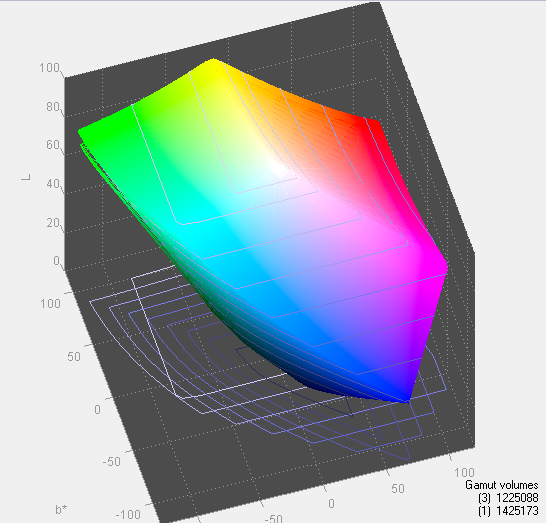
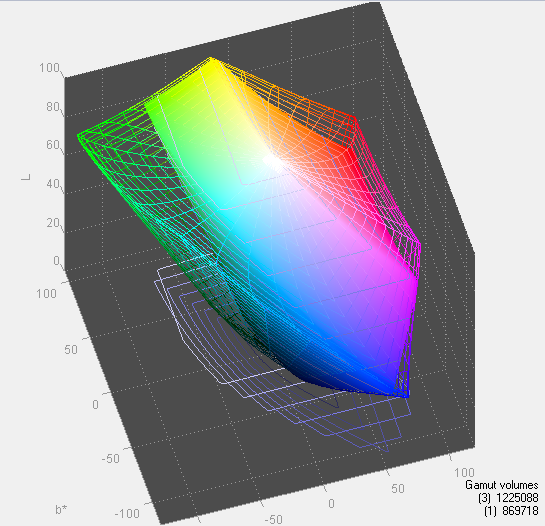








123 Comments
View All Comments
cjl - Friday, January 14, 2011 - link
1) All LCDs these days use overdrive. Whether advertised or not. It's the only way that an LCD can get a response time better than roughly 15-20ms.2) This is an IPS panel. The Alienware is a TN. TN panels are able to do 120Hz better than IPS. That's one reason why this isn't 120Hz.
3) 120Hz 2560x1600 is not doable with any current display connector other than possibly DisplayPort. Dual link DVI is only able to drive it at 60Hz, and HDMI can't even get up to native.
MeanBruce - Friday, January 14, 2011 - link
Ordered an Asus 6870 DirectCU from Newegg, it has 2 DisplayPorts regular not mini. Will I have to use both to run 120Hz 2560x1600? On this or HPs 30inch?cjl - Friday, January 14, 2011 - link
Neither is capable of 120Hz operation, so it doesn't matter how many connectors you hook up, it will never run faster than 60Hz. If someone were to release a 120Hz 2560x1600 panel, I believe that the newest DisplayPort standard could drive it with one connector. Other than that, no existing connector could pull it off.DanNeely - Saturday, January 15, 2011 - link
HDMI 1.3/1.4 have the same bandwidth as DVI, so they could drive a 2560x1600x60hz display.MeanBruce - Friday, January 14, 2011 - link
I gitcha ;) and agree, Dell should have put so much more into this panel, or should offer another 30inch with full RBG and a remote for switching inputs and volume tied to the Soundbar.Breit - Friday, January 14, 2011 - link
What about the 10Bit color support? Where you able to test it during your review? I personally own a Dell 3011 but have never seen any option to enable it on my ATI/AMD GPUs (neither 5870 nor 6970) even through different connection options (DP, DVI, HDMI). It must be a professional-only feature, at least for the red GPU camp?! Maybe this is the way to gain access to a calibrated Delta-E below 1.0 ... ;)Toshio - Friday, January 14, 2011 - link
For those interested in this monitor for gaming, here's a comparison of Dell 3007WFP-HC and 3008WFP:http://www.digitalversus.com/duels.php?ty=6&ma...
Unfortunately, none available anymore at dell.com :(
I personally own the 3007WFP-HC basically for gaming and I can tell you lag is not noticeable at all (just as it was with the original 3007WFP).
I'm not sure what method was used to measure lag in the U3011, but if it's similar to the older 3007WFP-HD I think we got a winner here.
As somebody else said, we would like to see this monitor's specs compared to previous Dell models. The ones I've personally tried are:
2408WFP (first revision) - Horrible Lag, no good for gaming at all. Average lag accordign to digitalversus: 69ms
3007WFP - Unnoticeable lag, good response for FPS gaming.
3007WFP-HC - same as previous.
3007WFP - I haven't tried this one but most reviews show terrible input lag.
What you'll find as common ground is that lag-free monitors don't have DSP (thus no OSD) and only DVI inputs, while the ones with more inputs and features (HDMI, OSD, monitor scaling) have noticeable lag. If Dell managed to cut lag while giving good features we surely have a good alternative in the U3011.
mac2j - Friday, January 14, 2011 - link
Should have been RGBLEDShould have been 120Hz which is totally supported by the current generation of graphics cards through displayport 1.2 or HDMI 1.4
Ryan Smith - Friday, January 14, 2011 - link
HDMI: No. I'll go light on the technical details, but it doesn't have enough bandwidth to drive 2560 at 120Hz (it has about half as much as necessary). Frame packing actually makes this really ugly - for 3D as defined by HDMI it only has enough bandwidth for 1080P 24Hz.DP1.2: Yes. However this monitor has been out for a few months, which is to say that it came out before anyone had a DP1.2 display controller ready. DP1.2 displays won't be out until later this year.
AnnonymousCoward - Saturday, January 15, 2011 - link
HDMI: yesDP: yes
DVI: yes
VGA: yes
No one said it has to be at 2560. In an FPS, 1680x1050@120Hz is better than 2560x1600@60Hz.